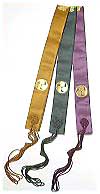Hey friends
When sewing the "pine needle" symbol in my Rakusu, it seemed to me more like it was a kind of "unfinished rectangle" in perspective, with 3 or even 4-dimensions, than a "pine needle" or even a "mountain", etc.
Don't know if the "diagram" of the Pine Needle was modified to be precise like the designing we can see nowadays, or if it should be stitched free-form, just resembling the "official" picture. I'm referring to the "official" pine needle design.
I've seem some explanations here and there, but none seems to explain where did it really came from and when it became a symbol of distinction between Zen schools. Do we have this kind of information (or some pointers to where should one start to look after it, I mean historic documents?)
Gassho
Marcos
#SatToday
When sewing the "pine needle" symbol in my Rakusu, it seemed to me more like it was a kind of "unfinished rectangle" in perspective, with 3 or even 4-dimensions, than a "pine needle" or even a "mountain", etc.
Don't know if the "diagram" of the Pine Needle was modified to be precise like the designing we can see nowadays, or if it should be stitched free-form, just resembling the "official" picture. I'm referring to the "official" pine needle design.
I've seem some explanations here and there, but none seems to explain where did it really came from and when it became a symbol of distinction between Zen schools. Do we have this kind of information (or some pointers to where should one start to look after it, I mean historic documents?)
Gassho
Marcos
#SatToday










Comment